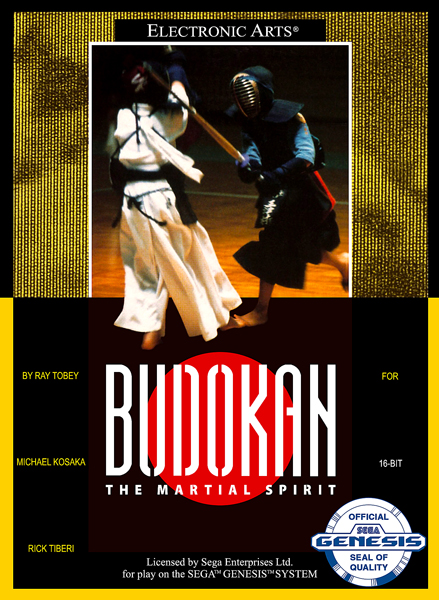
Budokan: The Martial Spirit
System: Genesis
Release Date: July 1990
Developer: Electronic Arts
Publisher: Electronic Arts
Genre: Fighting
Learn the way of the true warrior in Budokan: The Martial Spirit! Rescued from the mean streets by your father’s old sensei, you move to Japan to begin your training. Learn four different martial arts to prepare for the Budokan. Win twelve battles to become a true master.
Through the upcoming battles, you must become proficient in Karate, Kendo, Bo, and Nunchaku fighting styles. You can begin by practicing the maneuvers solo. Getting used to the directional pad is the most important part of playing. Forward and back ready you to launch an attack. Up jumps and can jump forward or backward. Down crouches and walks you forward or backward. When you get the feel of the controls, you can spar against one of the dojo instructors. This is a low stakes practice battle. The instructors take it easy on you so you can learn the feel of the strikes.
When you are sufficiently practiced, feel free to bother your sensei for words of advice. Train your mind as well as your body. Then head off to the Nippon Budokan to fight in the tournament. You see your next opponent, their level of skill, and their style. Based on this, you need to decide which style you are going to use in the match.
All styles work similarly. A combination of d-pad movements and attack button (A, B, or C) activate specific attacks. Timing is essential and will change as your stamina depletes. Stamina is your life bar. It depletes both as you get attacked and as you throw attacks of your own. Do not let hostile thoughts dictate your actions. You can hold back on attacks and build up your ki meter. As this fills, your attacks become more powerful. It drains as you attack, get hit, or are pushed off the mat for a fault.
Karate has the shortest range and honestly relies on jump kicking your opponent repeatedly. Kendo relies on range, but not speed. Keeping your opponent back while still being able to connect is the strategy here. Fighting with nunchaku is about speed and precision. The triple strike was a favorite of mine. Blocking and parrying are mostly miss with these styles, but the Bo is different. This is a defensive style. Blocking with the bo is very powerful and helpful against enemies who like to strike quickly.
The battles in the Budokan start off doable, but then become very difficult halfway through. You can only use each form four times during the tournament. These creates strategy, as you can’t just pick the bo each fight and build up your ki for a quick win. If you have achieved mastery of an art, you will reveal it in your every action. I’m sure there are people out there that can beat each opponent with every style, but I believe that each opponent has a weakness.
Some opponents use fighting styles that aren’t available to you, including the tonfa, kusari-gama, naginata, yari, and a dang ninja! The ninja is a pain in the butt because they’re cheap. The ability to throw unblockble shuriken is a stupid artificial difficulty bump. That, along with the incredibly fast stamina recovery that the AI enjoys requires you to be a master. Luckily a double KO goes to you. (1:48:00) The final boss, your sensei’s rival Tokage, mirrors the fighting style you choose. I finally found a use for Karate at the end.
Graphics: 2.5
Character models and animations are pretty decent, but not spectacular.
Sound: 2.0
Music exists, but is sparse and only in menus. Sound effects are martial arts grunting.
Gameplay: 2.5
Controls are surprisingly deep with changes to your effectiveness as stamina dwindles. That doesn’t mean everything is intuitive though.
Difficulty: 3.0
Once you realize this isn’t a twitchy fighting game, but something that requires strategy, it becomes more doable, but some later enemies are totally cheap.
Fun Factor: 3.0
I played for like three and a half hours total, so I must have been enjoying myself to some degree.
Overall Rating: 2.6
Budokan: The Martial Spirit earns a B-. I am amazed that an Amiga port has done this well. Maybe it just took the power upgrade of the 16-bit systems to make them work. Try this one.
